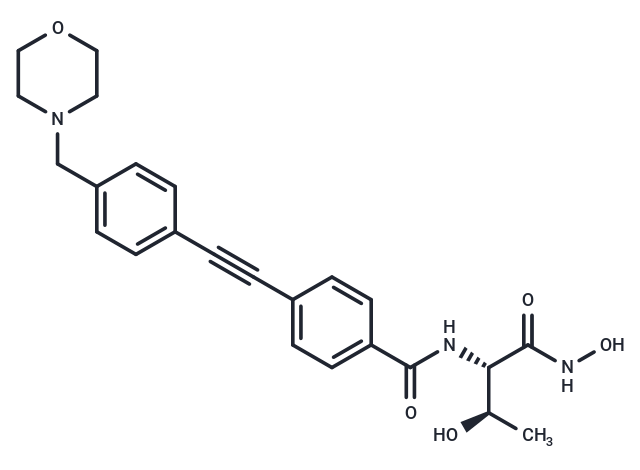Shopping Cart
- Remove All
 Your shopping cart is currently empty
Your shopping cart is currently empty

CHIR-090 is a very potent and selective LpxC inhibitor with antibiotic activity.

| Pack Size | Price | Availability | Quantity |
|---|---|---|---|
| 1 mg | $40 | In Stock | |
| 5 mg | $97 | In Stock | |
| 10 mg | $157 | In Stock | |
| 25 mg | $333 | In Stock | |
| 50 mg | $533 | In Stock | |
| 100 mg | $773 | In Stock | |
| 500 mg | $1,580 | In Stock | |
| 1 mL x 10 mM (in DMSO) | $97 | In Stock |
| Description | CHIR-090 is a very potent and selective LpxC inhibitor with antibiotic activity. |
| Targets&IC50 | LpxC:4.0 nM. (Ki) |
| In vitro | CHIR-090 is a highly effective, slow, tight-binding inhibitor targeting the LpxC deacetylase from Aquifex aeolicus, displaying significant antibiotic properties against Gram-negative pathogens like P. aeruginosa and E. coli. Its mode of action includes a two-step slow, tight-binding inhibition mechanism against E. coli LpxC, with an inhibition constant (Ki) of 4 nM, indicating potent activity at low nanomolar concentrations against LpxC orthologues from a range of Gram-negative bacteria including Pseudomonas aeruginosa, Neisseria meningitidis, and Helicobacter pylori. Contrarily, CHIR-090 exhibits weaker inhibition against LpxC from Rhizobium leguminosarum (Ki=340 nM), demonstrating a reduced efficacy and conventional inhibition pattern without the slow, tight-binding characteristic. This differential inhibition renders E. coli strains with LpxC from R. leguminosarum resistant to CHIR-090, even at concentrations 400 times the minimal inhibitory concentration effective against wild-type E. coli. Nevertheless, CHIR-090 showcases outstanding antibiotic efficacy against select pathogens, on par with ciprofloxacin, emphasizing its potential as a therapeutic agent. |
| In vivo | CHIR-090 is a potent E. coli antibiotic, demonstrating significant E. coli LpxC inhibition within the low nanomolar (nM) range in vitro. Notably, E. coli W3110 colonies resistant to a 1 μg/mL concentration of CHIR-090 do not occur unless subjected to prior chemical mutagenesis. However, a specific strain of E. coli W3110 can grow on LB agar with CHIR-090 concentrations ranging from 1 to 10 μg/mL, which is significantly higher (4 to 40 times) than the minimum inhibitory concentration (MIC) of 0.25 μg/mL identified under our conditions for the wild-type E. coli W3110. The growth rate of W3110RL strain is unaffected by 1 μg/mL CHIR-090, maintaining a doubling time of 40 minutes, identical to that of the wild-type strain without the inhibitor. Conversely, the wild-type strain ceases growth approximately two hours after exposure to 1 μg/mL of CHIR-090[1]. |
| Kinase Assay | Disk diffusion is conducted, except that 10 μg of each antibiotic compound is used per filter. Growth in liquid medium in the presence of CHIR-090 is evaluated as follows: cells from overnight cultures are inoculated into 50 mL portions of LB broth at an A600 of 0.02 and grown with shaking at 30°C. When the A600 reaches 0.15, parallel cultures are treated with either 6 μL of 500 μg/mL CHIR-090 in DMSO or 6 μL of DMSO. To assess cumulative growth, cultures are maintained in log phase growth by 10-fold dilution into pre-warmed medium, containing the same concentrations of DMSO or DMSO/CHIR-090, whenever the A600 reaches 0.4. The minimal inhibitory concentration is defined as the lowest antibiotic concentration at which no measurable bacterial growth is observed in LB medium containing 1% DMSO (v/v), when inoculated at a starting density of A600=0.01. Cultures are incubated with shaking for 24 h at 30°C in the presence of CHIR-090. Experiments are performed in triplicate[1]. |
| Alias | CHIR090 |
| Molecular Weight | 437.49 |
| Formula | C24H27N3O5 |
| Cas No. | 728865-23-4 |
| Smiles | C[C@@H](O)[C@H](NC(=O)c1ccc(cc1)C#Cc1ccc(CN2CCOCC2)cc1)C(=O)NO |
| Relative Density. | 1.33 g/cm3 (Predicted) |
| Storage | Powder: -20°C for 3 years | In solvent: -80°C for 1 year | Shipping with blue ice. | |||||||||||||||||||||||||||||||||||
| Solubility Information | DMSO: 60 mg/mL (137.15 mM), Sonication is recommended. | |||||||||||||||||||||||||||||||||||
Solution Preparation Table | ||||||||||||||||||||||||||||||||||||
DMSO
| ||||||||||||||||||||||||||||||||||||

Copyright © 2015-2025 TargetMol Chemicals Inc. All Rights Reserved.